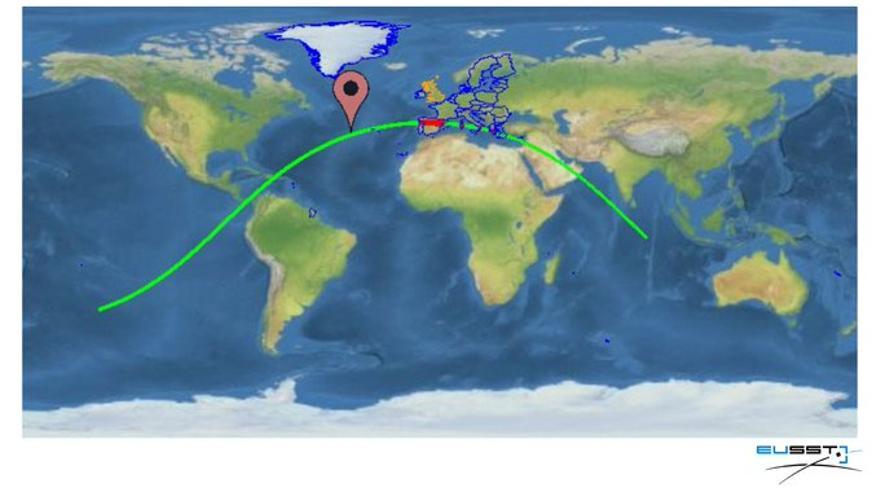Catalonia and others autonomous communities from the northern half of Spain They have closed this Friday morning air space due to the uncontrolled passage of a chinese rocket long march 5b, which finally fell in an area of the South Pacific Ocean at 11:01 a.m., peninsular time. The national air navigation manager enaire has followed the recommendations of the European Aviation Safety Agency (TO THAT) and has restricted All flights of the airports of Barcelona Y Girona – Costa Brava from 09:38 a.m. and 10:18 a.m. The preventive closure It has also affected the infrastructures of Ibiza, Aragon, and Navarra, La Rioja, and Castilla y León.
Air traffic has been restored at the scheduled time, but the affectations will be extended in the El Prat airport – Barcelona throughout the day in the form of delays. Until noon, 157 passenger and cargo flights out of the 759 scheduled for today have suffered delays, Enaire has detailed. In the infrastructure of Girona – Costa Brava, two operations have had delays of an hour and a half. Reus, for its part, has not suffered any setbacks because its operations did not coincide with the altered time slot.
There are no laws governing atmospheric reentries
Porcelain launched the fourth and last rocket on Monday Long March 5B (CZ-5B) from the Wenchang Space Launch Center, in Hainan. Like the other three, this Friday he has re-entered the terrestrial atmosphere in an uncontrolled way. This is surprising, but common, since there is no law or treaty that governs how space artifacts have to re-enter the Earth. Land. In fact, it is not the first time that the world has held its breath due to the uncontrolled fall of a space rocket.
Final destination: South Pacific Ocean
The area affected by the rocket trajectory has involved much of the northern half of the Iberian Peninsulafrom the coast of Mediterranean Sea until the Atlantic Ocean. In this line, the airport of Lisbon it has also ceased its operations temporarily as a preventive measure.
«The uncontrolled entry into the atmosphere of the Chinese space object has been monitored at all times by different national and international organizations and institutions,» he specified. enaire after the events have occurred. Until then, the authority that had warned only of the restriction of the changes had been Civil protection of the Generalitat de Catalunya, who made a tweet at 9:07 a.m.
Degut al risc associat pel pas de l’objecte espacial CZ-5B traversant l’espai aeri espanyol, s’han restrictit totally els vols des de 09:38 a les 10:18 hores a Catalunya y altres communitats.
The airports and organizations have already been informed
— Civil Protection (@emergenciescat) November 4, 2022
The rocket was scheduled to enter Earth’s atmosphere this weekendspecifically at 4.17 in the morning peninsular time on Saturday, according to the calculations provided by The Aerospace Corporation. Initially, the impact zone covered practically the entire planet, from the South of Europe to Africa in its entirety, passing through Australia and the entire American continent from North America to the south.
However, the latest predictions from the american corporation They advanced the re-entry and placed it at 12:20 p.m. in Spain this Friday with a margin of error of three hours. The final destination, the Indian Ocean. However, these estimates have not been met either, since it has finally fallen into the South Pacific.
Large Space Junk Footprint
The EASA has reported that the remains of the Long March 5B they are one of the most space debris largest recorded to date. The european agency has specified that the artifact weighed between 17 and 23 tons and had a size of 30 meters at the time of reentry. For this reason, he has warned that dropping the space junk in an uncontrolled manner «deserves careful monitoring».
Eurocontrol reports the uncontrolled re-entry of a Chinese rocket into the atmosphere. Zero Rate has been established to determine areas of Spanish airspace and this may affect air traffic in the form of ground delays and in-flight route deviations. pic.twitter.com/kfFBYG9s8z
— 😷Air Controllers 🇪🇸 (@controladores) November 4, 2022
first chinese space station
Related news
The four CZ-5B launches were part of the project to build the first chinese space stationwhich will be finished before the end of the year and will be called tiangong (Heavenly Palace, in Spanish). This rocket also had a concrete mission: send the laboratory module mengtian to the little one scientific city floating in space.
The coupling was a success and the Mengtian, together with the central module Tianhe and another lab called Wentianthey are already attached and the space station has a way of letter T. in full weight 70 tons and it is expected to work for 15 years in a low orbit, about 400 kilometers from the Earth’s surface.

